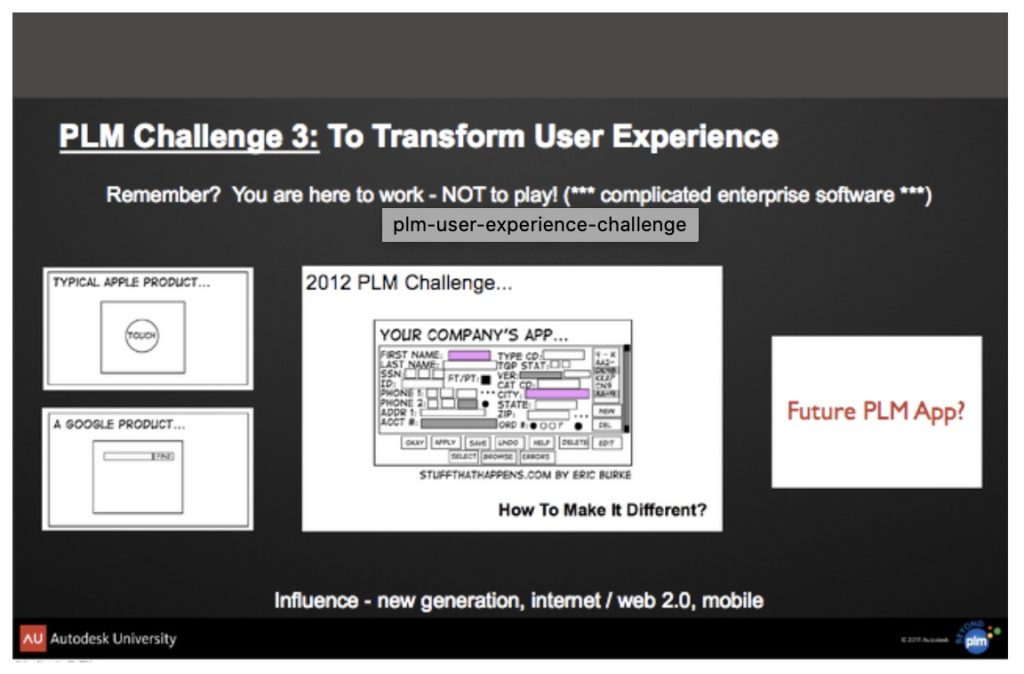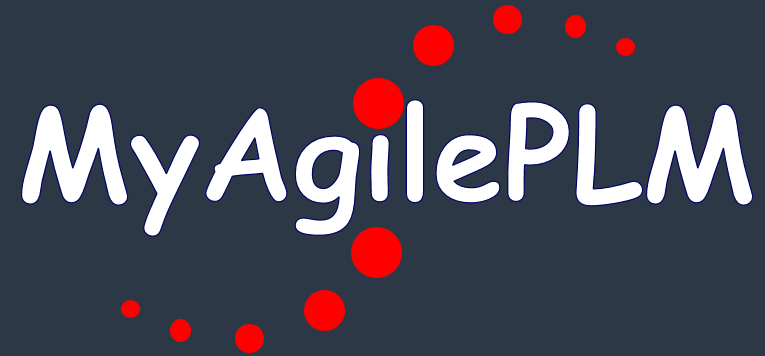
SharePLM post that started with one of my favs quotes from Leonardo Da Vinci “Simplicity is the ultimate sophistication” caught my special attention last week. It was a call about “simple PLM”, which is, in my view, one of the most controversial topics among PLM industry experts. I won’t hide my honest and true belief in simplification. It all started many years ago, when I was developing the AutoLISP app for AutoCAD, which has many options and commands. One of my first customers told me that although the app looks great and has many useful options, he actually wants to have a ONE BUTTON application that will do what he needs. When I asked him how I will figure that set of options he needs at any point in time, he answered – I don’t know, but it will be your problem :), not mine.
Product Lifecycle Management and Simplicity?
I found an article with my presentation from Autodesk University 2012 speaking about future PLM user experience. The slide below will celebrate 10 years anniversary, but the problem is still here and hundreds of “likes” given to the SharePLM post are the best indicator that the topic still touches the nerve of PLM professionals.

A decade later, I still can sign under my conclusion – there is no such thing as “PLM experience”. PLM is not a simple application that has a targeted user with a specific use case or role. PLM is more of a business discipline that has business goals, multiple roles, and diverse groups of users such as decision-makers, engineers, and many other consumers of digital information. Some of them do it every day, some others do it infrequently and some others even more occasionally. Besides that, many other organizations and individuals are involved in PLM business such as resellers, service companies, consulting people, and many others. Thinking about a few years ago, I wrote the article “Who needs simple PLM?” where I tried to explain the interests of every group that touches PLM business in one way or another.
Human-Computer Interaction and Simplicity
I’ve made an attempt to discuss various aspects of creating a simple PLM experience in my article – How to create a shared definition of Simple PLM Experience. If you are developing software, check this out. In my view, following these five principles can certainly help you to create a better application (not only PLM) –
(1) Minimize the number of tasks;
(2) Use clear descriptive labels;
(3) Create visual representations;
(4) always use “defaults” for any operations;
(5) Do less…
I followed these roles when started to build OpenBOM and it helped me a lot to create a better user experience that is appreciated by thousands of users and customers globally using the OpenBOM online service.
Jos Voskuil made a detailed and structured review of my article Who needs simple PLM? I like Jos’ conclusion:
Don’t confuse PLM with a tool, simple or complex. All PLM tools have a common base and depending on your industry and company’s vision there will be a short list. However, before you touch the tools, understand your business and the transformation path you want to take. And that is not simple !!
At the same time, as much as the idea to focus on business first and experience later, I wanted to share my experience of the last several years of working with many small and large companies and give my perspective about what are demands of customers and their process of PLM tool adoption I can see “in a wild” outside of theoretical debates of PLM professionals.
Simple PLM Circa 2022
PLM and product data management are complex disciplines. To manage product and all associated data is not simple. Global manufacturers are looking for simple, powerful, and efficient tools to help them in their design process to gain a competitive advantage and manage multi-disciplinary real-time data, and provide services for company users and other business users inside and outside of a company. Modern user experience gathers a lot of elements of communications in a variety of forums including traditional data management but goes beyond augmented reality, video streaming services, search services, and product lifecycle management to organize multiple processes using personal computers, and mobile devices. PLM system in 2022 is a central place where the company is expecting to get information about business performance, to provide an ultimate value, but at the same time to be a tool for team collaboration, helping to improve engineering performance and ability of companies to manage their business.
How do translate it into a plan and how simplicity is really important? The questions about how simplicity can help vendors to get market share, and develop an additional value for companies are critical. Here are 5 things I learned about simplicity for the last few years:
(1) Intuitive interface
(2) Following common user experience principles
(3) Guess what I need
(4) A combination of defaults and flexibility always wins
(5) There is always “one more feature needed”, so customer support is a key
The last thing trumps everything, in my view. One of my favorite customer experience quotes is belonging to a professional boxer Mike Tayson.

When Mike Tyson was asked by a reporter whether he was worried about Evander Holyfield and his fight plan he answered; “Everyone has a plan until they get punched in the mouth.” What Tyson said is similar to the old saying “no plan survives first contact with the enemy”.
What does it mean in the development of simple PLM? You cannot define it upfront. You need to start somewhere, but then you need to build the experience together with your customers and tune everything to make it real simple. Modern SaaS development tools are your best friends and thinking upfront about flexibility will be your life savior when you will have to adapt to the reality of the business.
What is my conclusion?
In 2022, PLM vendors are facing very sophisticated users with high demands for simplicity, intuitiveness, and flexibility. The leading expectations are coming from the point of using well-known paradigms coming from consumer applications, web tools, and general-purpose business applications. The standards are super high for PLM vendors unlike 20-25 years ago when the competitor was “another PLM system”. These days, every business and not only tool gives an idea to a customer about user experience, ease of use, simplicity, and overall intuitiveness. Therefore, a simple PLM is quickly becoming a big deal and challenge for all vendors. Just my thoughts…
Best, Oleg
Disclaimer: I’m co-founder and CEO of OpenBOM developing a digital cloud-native PDM & PLM platform that manages product data and connects manufacturers, construction companies, and their supply chain networks. My opinion can be unintentionally biased.
The post Simple PLM System “Circa 2022” appeared first on Beyond PLM (Product Lifecycle Management) Blog.



Be the first to post a comment.